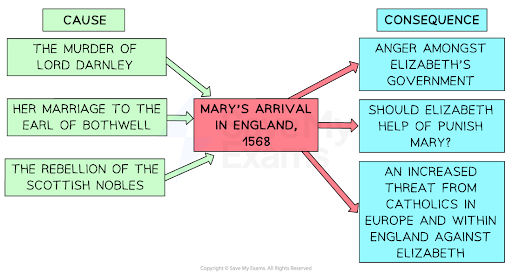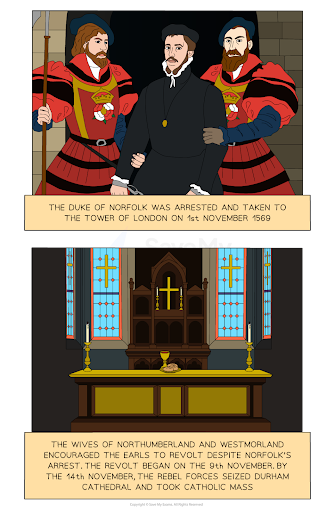Why Were the Catholics a Threat to Elizabeth I (WJEC Eduqas GCSE History): Revision Note
Exam code: C100
How did previous Tudor monarchs contribute to Catholic opposition in Elizabethan England? - Summary
The origins of the Catholic threat to Elizabeth I were caused by the earlier Tudor monarchs. For example, Henry VIII’s break with Rome, Edward VI’s Protestant reforms, and Mary I’s restoration of the Catholic Church in England left England deeply divided by religion when Elizabeth came to the throne in 1558.
In an attempt to unify the people, Elizabeth created the 1559 Religious Settlement with a ‘middle way’. However, many Catholics rejected the Religious Settlement and continued to see Elizabeth’s reign as illegitimate.
The existence of Mary, Queen of Scots, a Catholic with a legitimate claim to the throne, along with foreign support for plots and rebellions from France, Spain, and the Pope, further increased the Catholic threat.
Elizabeth was left with no other choice than to act by introducing Acts of Parliament, imposing fines on recusants, and even executing rebels to protect the crown and to secure Protestantism in England and Wales.
Early Toleration of the Catholic Religion
Historians believe that the majority of people living outside of London in 1599 were Catholic
This is why Elizabeth was cautious and decided on the ‘middle way’, to prevent a rebellion
During the first ten years of her reign, Elizabeth was tolerant of Catholicism due to the
Fear of foreign intervention if she were too harsh on Catholics
Large amount of opposition from the House of Lords
Fear of rebellion
Knowledge that most people were still Catholic
However, due to the events of the 1560s and 1570s, Elizabeth was forced to become harsher on Catholics who did not follow the Religious Settlement
Mary, Queen of Scots
Mary was a direct descendant of the first Tudor King, Henry VII
This made Mary, Queen of Scots, Elizabeth’s second cousin
Mary’s parents were James V and Mary of Guise
Mary became Queen of Scotland in 1524, when she was six days old
In 1558, Mary married the heir to the French throne, Francis II
King Francis II died in 1560
Mary returned to Scotland
Mary was disliked in Scotland
She was a Catholic in a Protestant country
It was suggested that she murdered her husband, Lord Darnley
Their marriage was not a happy one. Darnley had Mary’s Italian secretary, David Rizzo, murdered in front of her
A few months later, Darnley was found strangled in the garden, and his house was on fire
Three months later, Mary married the Earl of Bothwell
Scottish lords were unhappy and rebelled against her
Mary was forced to leave Scotland in 1568
Mary left her infant son, King James VI
She went to England to seek help from her cousin, Queen Elizabeth I

Examiner Tips and Tricks
Although you will not necessarily be asked a question on Mary, Queen of Scots’ background, it is essential to understand this information. It will help you to understand why Catholics were such a serious threat to Elizabeth.
Mary Queen of Scots’ arrival in England created many problems
Protestants feared the return of a Catholic queen
Approximately 300 Protestants were burned by Mary I during her reign
Many Catholics saw this as an opportunity to restore a Catholic queen to the English throne
Parliament and the Privy Council saw it as a threat to the security of the country and the queen
Elizabeth had to act because she could not allow Mary to be a free subject in England
Elizabeth’s options were to
Send Mary, Queen of Scots, back to Scotland
This would result in Scotland being a closer ally and remove many threats to Elizabeth’s throne
However, it was likely that Mary would be executed, and Elizabeth did not like this, as she was a legitimate queen and her cousin
Allow Mary to go to France
Mary could gain strength in France and attempt to take the throne
Keep Mary under house arrest in England
Mary would be under constant surveillance
However, Mary would remain a threat, and Catholics could use her in plots against Elizabeth
Execute Mary
This would remove any threats to Elizabeth's reign, and many members of the Privy Council supported this idea
However, it would anger Catholics and could result in a foreign invasion
Elizabeth decided to place Mary Queen of Scots under house arrest
Mary remained under house arrest for 19 years
Mary was named in many Catholic plots during Elizabeth's reign
This resulted in the rules of Mary’s house arrest becoming stricter, and surveillance increased
Many members of the Privy Council tried to persuade Elizabeth to execute Mary during those 19 years
Rebellion of the Northern Earls
Causes of the Rebellion of the Northern Earls
The Northern Earls of Northumberland and Westmorland rebelled in 1569 because:
The earls had grievances with the rule of Queen Elizabeth I
Factors within England gave them an ideal opportunity to depose Elizabeth
Recusancy was very popular amongst the Catholic nobility
Historians estimate that one-third of the English nobility did not attend Church of England services
The North-West of England contained the majority of recusants
The earls of Northumberland and Westmorland were angry with Elizabeth’s Religious Settlement
Under Mary I, they had gained wealth and power
Under Elizabeth, they no longer influenced the royal court
Elizabeth created many new nobles that did not stem from the ancient aristocratic families of England, such as Robert Dudley, Earl of Leicester, and Sir William Cecil
The Spanish Ambassador, De Spes, told both Northumberland and Westmoreland that Spain would support a Catholic rebellion against Elizabeth
However, Philip II was cautious not to commit to military intervention at this stage
He believed that if Mary, Queen of Scots, became queen, she would favor France over Spain

The Key Events of the Rebellion of the Northern Earls
The rebellion of the Northern Earls lasted for two months and had the potential to succeed

Why did the Rebellion of the Northern Earls fail?
Northumberland and Westmorland’s revolt failed because:
The Spanish troops never arrived in Hartlepool
Elizabeth managed to raise an army of 14,000 men
This vastly outnumbered the rebels
Northumberland and Westmorland were poor military leaders
As soon as they heard the Earl of Sussex was marching towards them, they fled
The rebels were not unified on the plan
Some believed they were overthrowing Elizabeth, while others thought they were just freeing Mary, Queen of Scots
Elizabeth’s government did not panic
Her government prevented the rebels from capturing key areas such as York
Westmorland and Northumberland did not persuade the Catholic earls to rebel
Most English Catholics did not support or join the revolt
France, Spain, and the Pope did not endorse the revolt
The Consequences of the Rebellion of the Northern Earls
Northumberland was captured by James Douglas, Earl of Morton
He was taken to Elizabeth in 1572
He was later interrogated and executed in York
Westmorland escaped England and lived in Flanders in poverty until his death
The Duke of Norfolk was arrested but later released from prison and pardoned in 1570
Over 800 rebels involved were executed
The Rebellion of the Northern Earls showed that:
Despite concessions, some English Catholics still wanted to depose Elizabeth
Catholics posed a significant threat to the stability of England
Catholics needed to be monitored and regulated
Elizabeth was willing to use violence against her subjects to protect her monarchy
The Revolt of the Northern Earls was significant in how Elizabeth treated Catholics throughout her reign
Elizabeth’s Excommunication
In February 1570, Pope Pius V released a papal bull
Stating that
Elizabeth was a ‘servant of wickedness’
Elizabeth was not the lawful queen of England and Wales
All catholics should plot against Elizabeth
Elizabeth was excommunicated from the Catholic Church
Elizabeth responded by issuing the 1571 Treason Act, which made it treason to
State that Elizabeth was not the lawful queen
To introduce or publish the Papal Bull
It also allowed Elizabeth to confiscate property from Catholics who fled abroad and did not return for 12 months
Recusancy
Throughout the 1570s, 1580s, and 1590s, Catholics continued ignore the Religious Settlement
Some Catholics refused to attend Church
As they were not prepared to compromise over their religious beliefs
In 1568, William Allen in France taught priests that it was their duty to return to England and re-establish the Catholic faith
From 1574, seminary priests were being smuggled into England and Wales from France
Approximately 438 seminary priests were sent to England and are believed to have helped the Catholic plots against Elizabeth
Many seminary priests were Jesuits, members of the Roman Catholic missionary order called ‘The Society of Jesus’
They aimed to remove Protestantism
They arrived in England from 1580, stating that Catholics should not accept the Religious Settlement
In 1580, two Jesuit missionaries, Robert Parsons and Edmund Campion, came to England

Robert Parsons escaped from England and never returned
However, Edmund Campion was arrested, tortured in the Tower of London, and hanged, drawn, and quartered for treason
Due to the threat posed by recusants, Jesuits, and the seminary priests, Elizabeth and her government responded by introducing Acts of Parliament to deal with these issues
The 1571 Treason Act
Made denying Elizabeth’s Act of Supremacy illegal
Enforced recusancy fines for Catholics who refused to attend Protestant services. This was not strongly enforced
Made it illegal to own Catholic items such as rosary beads
The 1581 Act of Persuasions
Forced recusants had to pay a fine of £20 per month, which was strongly enforced
Attending Catholic mass was treason
Converting to Catholicism was high treason
1585 Act against Jesuits and Seminary Priests
Stated that all Catholic priests must leave England or be executed
Anyone sheltering a Catholic priest would be arrested
1593 Act Restraining Recusants
Catholics had to stay five miles from their home
If Catholics wanted to travel more than five miles from their home, they had to ask permission from the authorities
Remaining Catholic threat
Although there was still a Catholic threat against Elizabeth in the 1590s, it was small
Catholicism was not popular among ordinary people
By 1603, approximately 10% of the country was Catholic
Most people wanted to support England and Elizabeth
Supporting Catholicism was seen as not English

Unlock more, it's free!
Did this page help you?